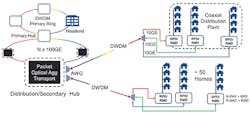Coping With the Bandwidth Explosion (The MSO Perspective)
Simplifying 10 Gb/s DWDM for Mass Deployment in Fiber Deep Access Networks —
Optical networks across the globe are on the cusp of 2 major architectural changes that bring many advantages to network operators. But they also present significant challenges that must be overcome before they can fully achieve their potential benefits. They are Distributed Access Architectures (DAA), which will radically change cable multiple-systems operator (MSO) networks, and the move to 5G in mobile networks, which will impact a wide range of networks including those built by mobile operators themselves and those built to support wholesale services for mobile operators.
These 2 trends have many similarities as they push fiber deeper into their respective access networks and rearchitect aggregation and transport networks to cope with a step change in bandwidth, higher performance, better economics, and increased automation. Both bring an order of magnitude increase in access network connectivity, with a jump in backhaul bandwidth requirements from 1 gigabit per second (Gb/s) to 10 Gb/s.
DAA and 5G offer us a vision of the future, with an enormous leap in both network capabilities and the services operators are able to offer. But the technological advances associated with these new architectures bring with them some new operational challenges that need to be addressed before DAA and 5G can deliver on their full potential. In this article we’ll look at one of the major operational challenges in pushing dense wavelength-division multiplexing (DWDM) deep into access networks, and we also look at corresponding innovation from the optical networking industry to address this issue.
DAA and 5G Push Fiber Deep
DAA is a major evolution of the cable access network and the associated aggregation and transport network. A key element of DAA is that it replaces the older analog access network with many new fiber-connected Remote PHY devices (RPDs) or Remote MAC/PHY devices (RMDs). These require a new 10 Gb/s DWDM backhaul link, as shown in Figure 1.
Figure 1. Distributed Access Architecture
Previously, the DWDM transport network terminated at the secondary or distribution hub, which aggregated traffic from the subtended analog access nodes. But with DAA, DWDM needs to extend out to hundreds of new locations per secondary hub. To put this fiber deep initiative into perspective, DAA networks will have tens or hundreds of thousands of RPDs/RMDs, and the largest may ultimately have over a million. This trend is known as fiber deep in the cable MSO community for a good reason!
5G also brings an element of fiber deep to mobile transport networks. The changes required for 5G within the transport network are manifold, but one significant trend is the proliferation of small cells and the increased use of fiber wherever possible for the backhaul of these small cells to provide the higher bandwidth that 5G requires. Many 4G cell sites are already connected by fiber, so this isn’t such a big change as in DAA, but 5G will still drive a fiber deep mind-set in network planners.
Together, these fiber deep trends will bring great benefits to network operators and end users, but network operators need to address the challenge of rolling out DWDM technology to a significantly higher number of end points than today. This needs to be done as simply as possible, enabling existing access network engineering crews to add DWDM without the need for complex additional installation procedures and training.
InvisiLight® Solution for Deploying Fiber
April 2, 2022Go to Market Faster. Speed up Network Deployment
April 2, 2022Episode 10: Fiber Optic Closure Specs Explained…
April 1, 2022Food for Thought from Our 2022 ICT Visionaries
April 1, 2022Fiber Deep Optics Options
DWDM optics today come in 2 main groups:
1. Fixed-wavelength optics with a lower cost but requiring the management of a full range of individual per-wavelength optics modules.
2. Tunable optics offering a single module for all sites but requiring a significantly more complex installation process.
Both can be used in fiber deep applications, and both require detailed planning to ensure field technicians have the correct installation information and install the right wavelength at every location. When a moderate number of sites are needed for a network, the use of DWDM in access nodes is not a major issue, but when hundreds of thousands of access nodes are potentially involved, it may become a major concern for network operators.
One recent optical networking innovation that has the potential to address this issue is the creation of autotuneable DWDM optics. These optics can effectively learn their required wavelength from the network. This means that field technicians and host systems for the remote optics, RPDs, RMDs, cell site routers, or other network infrastructure, can treat these optics as if they are grey, uncolored optics. This brings considerable advantages as it means that more complex DWDM installation procedures can be avoided, saving time and removing the need for additional training and allowing the existing field technician force to deploy DWDM optics as part of their RPD/RMD/5G cell installation procedures. This effectively brings zero-touch provisioning to DWDM optics installation. For those familiar with the IP world, this can be considered the optical equivalent of Dynamic Host Configuration Protocol (DHCP) in terms of its benefits.
Autotuneable optics work by implementing a communications channel between the optics at either end of the link, using a scanning technique to search for the required wavelength or a combination of the two. Depending on the technique used, the optics can work over single- or dual-fiber access plant, allowing great flexibility in deployment scenarios and having no impact on the optical performance and reach/distance specification of the optics.
One of the greatest advantages of automating the installation process in this way is that it avoids miscommunication or planning errors as the optics can only ever tune to the specific wavelength of the port they are physically connected to. This is due to scanning techniques that utilize the fact that DWDM filters are built using arrayed waveguide (AWG) technology that allows only the correct wavelength through the network. Any other attempted wavelength is blocked by the AWG filter, ensuring that it doesn’t affect any other traffic in the network. Only when the correct wavelength is attempted does the network allow light to pass from the scanning autotuneable optic to the far end.
While the techniques are simple at the high level, they involve sophisticated details to ensure that operation is robust, and optics can autotune in a realistic time period, typically within a couple of minutes or less. Those details are hidden from the field technicians, who simply insert the standard optics module, connect the fiber, and allow the optics to turn themselves up.
Summary
Autotuneable optics, such as Infinera’s Auto-Lambda technology, have the potential to revolutionize the deployment of DWDM optics in access networks. This revolution is very timely as new network architectures are about to massively proliferate 10 Gb/s DWDM into access networks for DAA, 5G, and many other network and service innovations.
The operational impact of the proliferation of DWDM end points in networks shouldn’t be underestimated. Autotuneability has the potential to greatly reduce operational cost and complexity, speed up installations, and greatly lower the risk of installation errors that compound deployment challenges.
About the Author
Jon Baldry
Senior Director, Solutions Marketing, Nokia
Jon Baldry is Senior Director, Solutions Marketing at Nokia. He has more than 30 years’ experience in telecoms and optical networks specifically. For more information, please email [email protected] or visit www.nokia.com. You can also follow them on LinkedIn, Facebook, and X.





